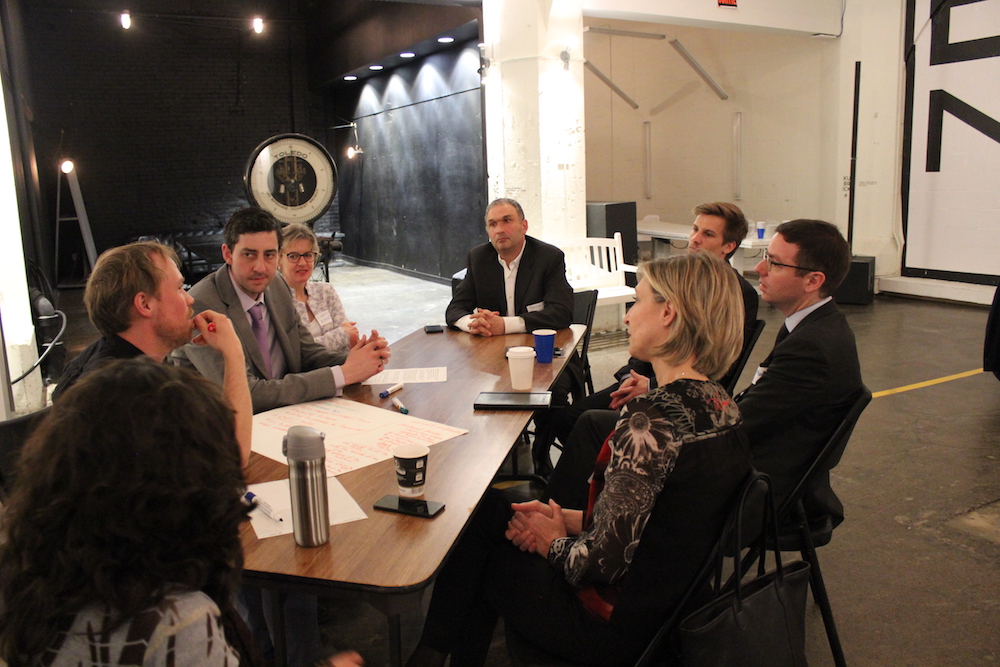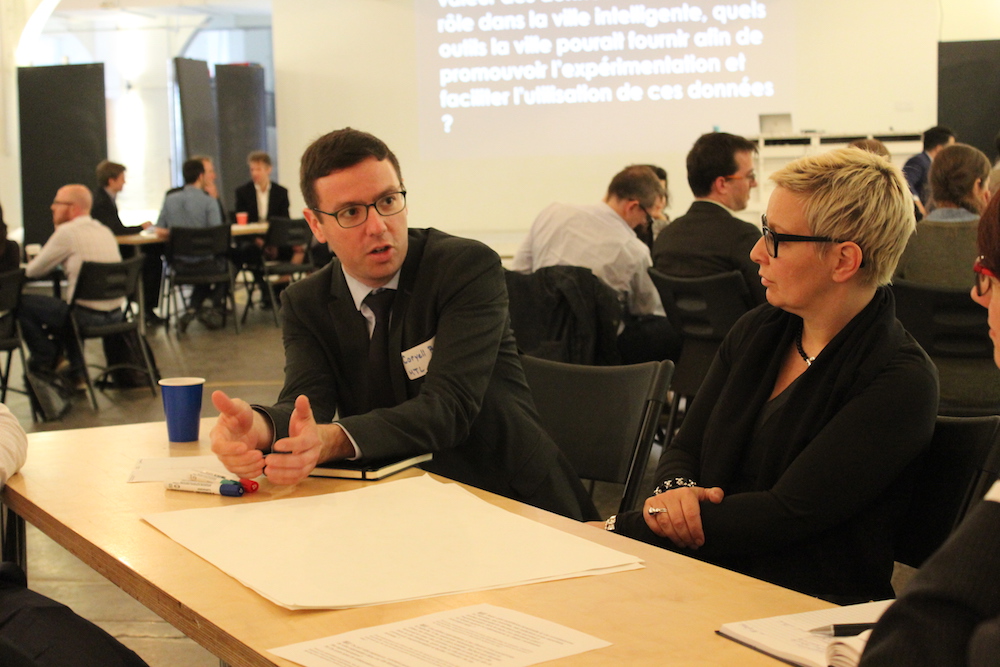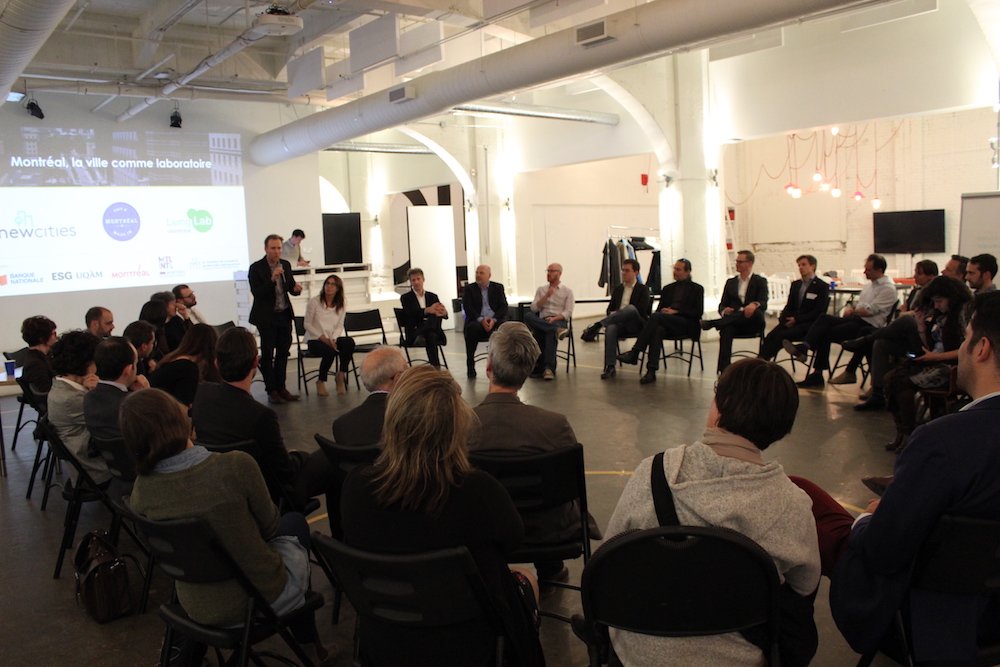
Making Collaboration Possible in the ‘City as a Laboratory’
June 14, 2017 — Blog
NewCities, in partnership with Living Lab Montréal and Made in Montréal, hosted a series of roundtable discussions featuring a cross-section of Montréal’s leading actors and creative minds. The third roundtable in this series took place at Sid Lee’s 8 rue Queen on May 3, 2017 on the subject Montréal: City as a Laboratory.
Imagine stepping into a ‘flagship store’ that was the public face for your city, a storefront where you would be welcomed by a savvy representative who would be the point of contact for open data, mobile apps and contacts you need to engage with the city, or develop and pilot an innovative idea. In Montréal, and most cities, there is no shortage of municipal buildings and institutions, but this different approach may make the city all the more approachable, making engagement with the city an enjoyable experience.
This idea emerged from the conversation during the roundtable discussion focused on making the City of Montréal a laboratory for new ideas, the third instalment in a months-long series. The flagship store is one potential answer to the challenge that we need a new ‘point of contact’, one that would welcome new ideas and become a catalyst for the new networks and new initiatives needed in a city to truly become a laboratory.

Among the main themes in the roundtable discussion is the strong desire to collaborate and experiment in Montréal, from those across different sectors and in a variety of fields. Among the obstacles to achieving this goal is the fact many don’t know where to begin. Connecting with municipal institutions is complicated, to say nothing of the variety of organizations and individuals working to drive innovative new services and solutions for life in the city. Considering the city as a laboratory is a useful way to imagine how collaboration between those developing radically new approaches to local issues can result in major breakthroughs that improve quality of life. The roundtable discussion looked at where to begin.
Improvement Through Experimentation
As citizens of Montréal, participants from various backgrounds and expertise were in tune with many of the local issues that could most benefit from creative experimentation and collaborative efforts. As a densely populated, mid-size North American city, many of the main challenges facing Montréal are shared by cities around the world. Participants identified several areas where experimentation and the creation of the laboratory city could lead to new solutions.
For example, Montréal’s four universities (and their university libraries) all claim to lack space, yet they are not integrated or coordinated. One idea presented – that could apply to universities as well as other urban spaces – was to bring together technologists and experts in blockchain to devise new tools to share and optimize the use of spaces. Universities are particularly important contributors to the ‘city as a lab’, as they can test, prove, and write about new solutions. Often, insights and new ideas get stuck in drawn-out processes before they are shared more widely. By planning for failure and radical experimentation, the city as a laboratory could welcome more exchange of knowledge and insights during the experimentation phase.

Similar collaborative efforts could be used to tackle a range of issues, including: technological support services for the elderly living downtown, new ways to scale local food production and distribution in sustainable agriculture, and, with Montréal’s growing A.I. hub, laboratories to test the models and implications of automation of services and local manufacturing. Providing these test beds, and support for those involved in experimenting, was cited as a significant way for the city to demonstrate its willingness to solve social and logistical issues in a practical, applied, and relatable way.
No Data, No Experimentation
Throughout the roundtable series, participants agreed on the central importance of viable data to develop new tools and innovations that benefit city life. More importantly, however, many pointed out that small organizations and citizens often do not have the capacity or necessary resources to use this data – even if it is openly available. Given that Montréal has embraced open data and its role in the smart city, what are the next steps to promote experimentation and productive use of this data?
One participant offered a fitting analogy on data and the role of collaboration in a laboratory city: when you go to a restaurant, you don’t expect the cook to manage everything from growing the carrot to preparing and serving the meal. You go to the restaurant not just for the food, but to have an experience, whether it be a greasy spoon or haute cuisine. As is the case with food, so it goes with data. Intermediary processes and transformations are as integral to data as growing, shipping, and preparing food. How can we imagine the city and other organizations at work in a supply chain that brings city-level data from raw material to useable products that empower others to transform and to find new uses for it?
The city must be able to put data in an understandable context so that it reflects local realities and may benefit from the expertise of local residents, organizations, and companies who use it. The roundtable discussions made it clear that there is a missing link.
In the city as a laboratory, there is clearly a need for a new and improved point for engagement between citizens, organizations, and the city, exemplified by the flagship store or other responsive support center. This goes beyond accessing data to the need for a point of reference connecting organizations, individuals, and initiatives that may team up or share information. Where the desire for collaboration and innovation exists, the city can build or facilitate these points of contact so that those willing and able know which door to knock on to get things started.
Ultimately, a digital or real-world point of contact facilitated by the city could create a dialogue between citizens and the city administration, enabling the distribution of data and creation of new tools. In effect, an on-the-ground strategy such as this could create a feedback loop that would allow citizens, organizations and the city itself to benefit from one another.
Learning to Love and Understand Data
An issue central to the discussion is the ability to manage expectations for the on-the-ground reality of available data and how it may help the city face challenges from transportation to urban development. One recommendation suggested the laboratory city can manage expectations while improving available resources through engaging citizens at a young age. Younger residents, students in particular, should become ‘data conscious’ well before they choose career specializations.
While this process has begun in high school classrooms and colleges across the city, they could be using the city’s existing open data in school projects, helping to energize citizens and encouraging excitement about using data to better understand what it can help accomplish.

Meanwhile, in order to succeed, the laboratory city will rely on the excitement and engagement of citizens. Engaging with citizens, making them part of the feedback loop with the city, is critical to the success of this urban experiment. Currently, citizens have too few access points with the city, given the complex nature of municipal jurisdictions, permits, and regulations around city spaces. What if the city were to create more space for experiments?
Creating a flagship store would be the ultimate experiment, connecting citizens directly to the resources, tools, and even the elected leaders tasked with making the city more innovative. This bricks and mortar approach is the embodiment of a more approachable city, one that uses public space to engage citizens on their terms, all with an eye to give people a larger role in the processes that are driving the change in Montréal.